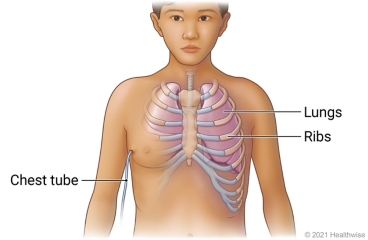What is a chest tube?
A chest tube is a hollow plastic tube. Your doctor puts the tube into the space around your lungs to drain away fluid, blood, or air. An injury to the chest or another condition may cause fluid, blood, or air to build up around your lungs. This buildup can also happen after some surgeries.
Having fluid, blood, or air in the space around your lungs can cause your lung to collapse. It can also cause infections or breathing problems.
How is the chest tube inserted?
Putting in a chest tube is considered minor surgery, and it may be done while you're awake. You may be in the hospital or an outpatient clinic when the tube is inserted. You may get medicine that relaxes you or puts you in a light sleep. The area being worked on will be numb. The doctor will make a small cut, called an incision, between two of your ribs. The doctor will put the tube through the incision and into the space around your lungs.
The tube will stay in your chest until all or most of the fluid, blood, or air drains out. This may take a few days. Your doctor may attach the tube to a machine that can help the space around your lungs drain better.
While the tube is in your chest, you won't be able to be very active. Your doctor may want you to stay in the hospital to get help with your chest tube, or you may be able to care for it at home.
What can you expect after the tube has been removed?
When the tube is removed, the doctor or nurse will tape a bandage over the incision. It will take about 3 to 4 weeks for the cut to heal completely. It may leave a small scar that will fade with time.
You may have some pain in your chest from where the tube was. For most people, the pain goes away after about 2 weeks. If your doctor prescribed pain medicine, take it as prescribed. If you aren't taking a prescription pain medicine, ask your doctor if you can take an over-the counter medicine, as needed.
Your doctor may want you to have a follow-up X-ray to make sure that fluid, blood, or air hasn't built up again in the space around your lungs.
Follow-up care is a key part of your treatment and safety. Be sure to make and go to all appointments, and call your doctor if you are having problems. It's also a good idea to know your test results and keep a list of the medicines you take.


